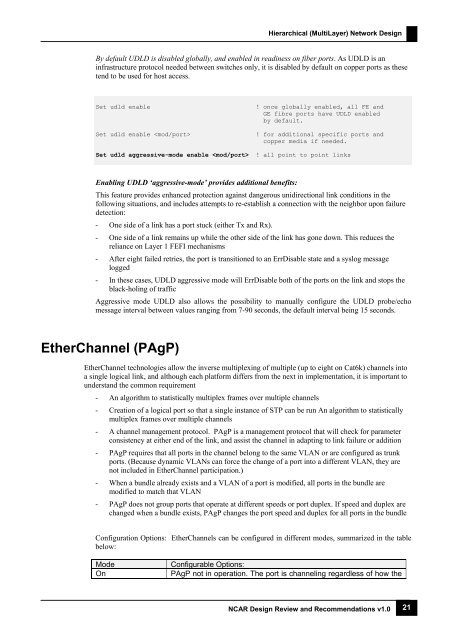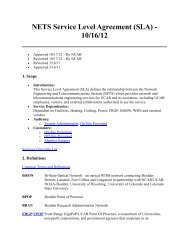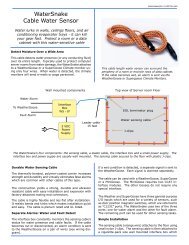Design Review Template - NETS
Design Review Template - NETS
Design Review Template - NETS
You also want an ePaper? Increase the reach of your titles
YUMPU automatically turns print PDFs into web optimized ePapers that Google loves.
Hierarchical (MultiLayer) Network <strong>Design</strong><br />
By default UDLD is disabled globally, and enabled in readiness on fiber ports. As UDLD is an<br />
infrastructure protocol needed between switches only, it is disabled by default on copper ports as these<br />
tend to be used for host access.<br />
Set udld enable<br />
Set udld enable <br />
! once globally enabled, all FE and<br />
GE fibre ports have UDLD enabled<br />
by default.<br />
! for additional specific ports and<br />
copper media if needed.<br />
Set udld aggressive-mode enable ! all point to point links<br />
Enabling UDLD ‘aggressive-mode’ provides additional benefits:<br />
This feature provides enhanced protection against dangerous unidirectional link conditions in the<br />
following situations, and includes attempts to re-establish a connection with the neighbor upon failure<br />
detection:<br />
- One side of a link has a port stuck (either Tx and Rx).<br />
- One side of a link remains up while the other side of the link has gone down. This reduces the<br />
reliance on Layer 1 FEFI mechanisms<br />
- After eight failed retries, the port is transitioned to an ErrDisable state and a syslog message<br />
logged<br />
- In these cases, UDLD aggressive mode will ErrDisable both of the ports on the link and stops the<br />
black-holing of traffic<br />
Aggressive mode UDLD also allows the possibility to manually configure the UDLD probe/echo<br />
message interval between values ranging from 7-90 seconds, the default interval being 15 seconds.<br />
EtherChannel (PAgP)<br />
EtherChannel technologies allow the inverse multiplexing of multiple (up to eight on Cat6k) channels into<br />
a single logical link, and although each platform differs from the next in implementation, it is important to<br />
understand the common requirement<br />
- An algorithm to statistically multiplex frames over multiple channels<br />
- Creation of a logical port so that a single instance of STP can be run An algorithm to statistically<br />
multiplex frames over multiple channels<br />
- A channel management protocol. PAgP is a management protocol that will check for parameter<br />
consistency at either end of the link, and assist the channel in adapting to link failure or addition<br />
- PAgP requires that all ports in the channel belong to the same VLAN or are configured as trunk<br />
ports. (Because dynamic VLANs can force the change of a port into a different VLAN, they are<br />
not included in EtherChannel participation.)<br />
- When a bundle already exists and a VLAN of a port is modified, all ports in the bundle are<br />
modified to match that VLAN<br />
- PAgP does not group ports that operate at different speeds or port duplex. If speed and duplex are<br />
changed when a bundle exists, PAgP changes the port speed and duplex for all ports in the bundle<br />
Configuration Options: EtherChannels can be configured in different modes, summarized in the table<br />
below:<br />
Mode<br />
On<br />
Configurable Options:<br />
PAgP not in operation. The port is channeling regardless of how the<br />
NCAR <strong>Design</strong> <strong>Review</strong> and Recommendations v1.0 21













